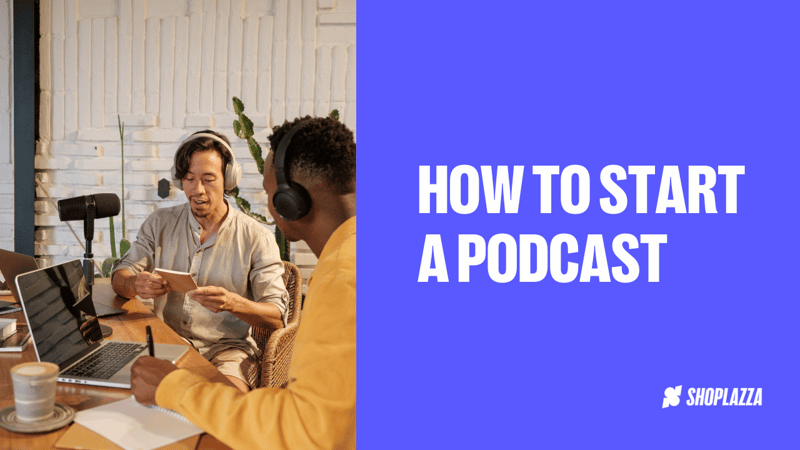
If you’re thinking about ways to cultivate and expand your business that don’t involve traditional marketing channels, how about starting a podcast? This guide will tell you everything you need to know about how to start a podcast for your online store. Check it out!
Chances are you’re no stranger to podcasts.
Maybe you listen to them while you’re stuck in traffic. While you work out in the gym, to turn those long minutes of physical exercise into something that’s slightly more endurable. While you do the dishes in the mornings, or while you reply to emails or work on a specific project? Maybe you have a podcast episode on right now, while you’re reading this.
Yep, we’ve all been there. Podcasts have been around for quite a few years now, and they’re already way past the novelty stage: They’re a mainstay in the content world, and everyone from reporters to writers, creators, celebrities and regular Joes use it.
But… Is there a place for businesses that want to start a podcast? And if there is, how exactly should you go about it?
Well, plug your earphones in and press play; we’re here to tell you how to start a podcast for your business.
🎧 And if you want to start an online store, why not check us out? Shoplazza offers tons of tools and resources to help online businesses grow.
What is a podcast?
A podcast is an audio broadcast uploaded to podcast platforms like Apple Podcasts, Spotify or Google Podcasts, and people can either stream the content directly online or download the audio files to listen to them later on.
It resembles an old radio broadcast, in that it’s traditionally made up of audio alone. This audio content is steered by the podcast host―the person that is the voice of that podcast and who either works alone or with another host.
Besides the voices that you hear on a podcast, the audio broadcast is sometimes accompanied by small bits of music that help introduce topics or tell a story.
Why should a business start a podcast?
The beauty of podcasting is that the format itself is immensely versatile. People use it to tell stories, to interview other people, to discuss important topics and to share their knowledge about something they’re passionate about.
This is exactly why e-businesses of every niche, size and business model can consider starting a podcast. You can take advantage of the medium to expand on three crucial aspects of your entrepreneurial journey.
With that in mind, let’s check out three reasons why brands and businesses should consider starting a podcast.
Build your brand as more than “just a brand”
Well, of course you want your brand to be known as a brand that sells stuff.
That’s probably the reason why you got into business in the first place, and if all goes well it’s the brand that you're building that'll help you reap the profits you dream of.
However, growing and expanding a business is also something that should be on your horizon. What do you want to do after you make those first sales and get to a point where the business is stable enough? How do you expand from there?
One solution is becoming an authority on something―ideally, on something that your business has mastered. And starting a podcast is a great way to do that.
Suppose you’ve built an online brand that is big on green marketing initiatives and is working exclusively with sustainable materials. In this case, a path that might be worth pursuing is migrating to the podcast format to showcase some of your partners and share tips on how to get started with a green business.
🎧 Sounds good? Then you might want to listen to this episode of “The Founder Hour” podcast, where the hosts interviewed Blake Mycoskie―the founder of TOMS, a brand known for its social involvement and its amazing One for One® model.
Pro tip on how to start a podcast
Having a business plan in place can definitely help you sort your priorities and plan accordingly for what’s to come.
Reach a wider audience
Online customer acquisition is always a pain, especially in terms of how to organize your marketing budget and the sheer manpower you need to bring those strategies to life. After all, you need to create, implement and constantly optimize campaigns to make sure you’re reaching all the metrics you want to achieve.
But the truth is, there are different ways to build an audience and a real community of fans. And this is exactly what a podcast can help you achieve.
In an era where visual content is being prioritized across every kind of social platform, podcast episodes can actually help your business connect with your target audience on a different level―and conquer the hearts (and ears) of people who perhaps weren’t even your main focus.
This can happen mainly because the way people search for (and engage with) podcasts is entirely different from what we normally see on social media.
Instagram, YouTube, TikTok and even Twitter demand the user’s full attention: You’re always watching, scrolling, liking, commenting, and sharing. But with a podcast episode, you’re listening. That’s it. You don’t even need to rate the podcast if you don’t want to; you can just press play and enjoy the content that’s coming through your ears.
And, if you’re a business, this means having a captive audience. Excellent, right?
🎧 You want to learn how to start a podcast but you also want your social media fix? Here are some guides that might be useful:
- TikTok Ads Manager: A Guide to Advertising on TikTok
- Like and Subscribe: How To Make Money on YouTube
- How to Use Instagram Stories: An Infographic for Your Business
Before we tackle how to start a podcast, it’s worth covering one last reason why the podcast format is good for businesses.
Strengthen brand awareness
Standing out on the internet is hard work, especially if you’re keen on growing at an organic and sustainable pace. There’s a lot of social media to manage, a lot of marketing strategies to try out, and a lot of emails to send.
And even after all is said and done, it’s very likely that people won’t necessarily be super aware of your brand and your products.
But building a strong branding strategy can be the perfect antidote for that. After all, the more people know about your brand, your mission statement and your products, the higher the chances that they become lifelong fans and customers.
And you know how you can make that happen? It starts with a P and ends with a T: Podcast.
🎧 Here’s a tiny soundbite: Think of your podcast as a long-term content marketing strategy. You shouldn’t start a podcast as a means to advertise your products but rather work towards crafting this format into a “branch” of your brand.
How much does it cost to start a podcast?
Okay, so you already know the why. Before we discuss how to start a podcast, let’s dig into how much it costs.
To properly budget for this strategy, you should consider two main areas of investment: the actual podcast equipment you’ll need to record your episodes, and the podcast hosting service you’ll use to edit and store your audio files.
Podcast recording equipment
You’ll need a few items to start recording a new podcast:
- Microphone: As we mentioned before, audio is key to the podcast format. It all depends on the voice you’re putting out there, so it’s crucial to get a good microphone to help make sure that your voice really carries and the recording doesn’t sound cheap or amateurish.
- Headphones: Professional headphones can do wonders for a podcast host, not least because it allows you to have a lot more control over what gets recorded by your microphone. Good headphones also allow you to modulate your voice a bit better, since you’ll be able to hear what you actually sound like during the editing step.
-
Pop filter: Cute name, right? A pop filter is a tiny layer of sound-proof material that you place between yourself and your mic, and it helps to ease out the consonant sounds we make when we speak those plosive consonants (you know, like p, b, d, g, t, k). With a pop filter, you can say things like gladly painting pictures and pickled pepper without making that awful little pop on the audio.
-
Podcast software for professional recording: Up next, you’ll need podcast software to record and edit your podcast episode. You can look up solutions like StreamYard, Iris.fm or Riverside. They offer a ton of editing and mixing tools to make sure your audio content really stands out, and their prices are also pretty reasonable. StreamYard even has a free plan, so it’s worth checking them out.
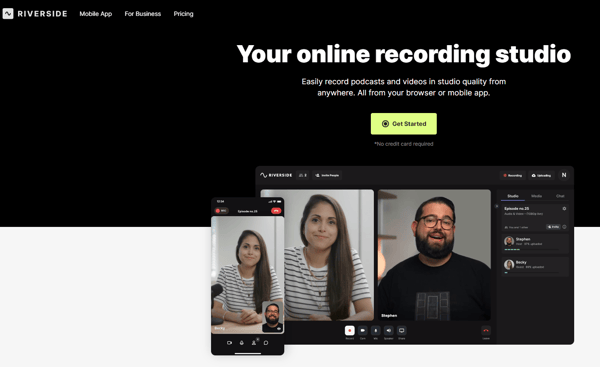
Podcast hosting platforms
Besides podcast equipment, you also need a platform to help you upload your content to all the major podcast directories like Spotify, Apple Podcasts, Podcast Addict and Amazon Music.
It’s also not a bad idea to have a specialized platform that’ll help you actually track your progress and see how many downloads you’re getting, how many listeners are engaging with your content, and plenty of other important metrics that can be extremely useful as your show gains traction.
This is where a podcast hosting platform comes in. There are plenty of options available online, but if you’re interested in how to start a podcast, we recommend sticking to solutions that have nice pricing and also offer remote recording software―like the ones below.
4 best hosting platforms for businesses that want to start a podcast
Solutions like Buzzsprout, RSS.com, Podbean and Transistor are good alternatives to help you get your podcast off the ground. They all offer very similar pricing options, and both Buzzsprout and Podbean have free plans that are definitely worth trying out.
Transistor and Buzzsprout, for their part, can hook you up with professional tools to distribute your content to all the major podcast directories and even help you out with paid and organic ads to expand your reach.
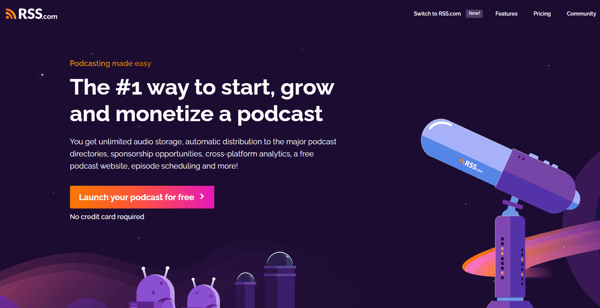
Pro tip on how to start a podcast
If you’re not ready to commit to a fully-fledged paid platform, Spotify for Podcasters can definitely help you out.
This free podcast hosting platform boasts analytics tools that can help you, as a podcast host, understand your audiences' engagement metrics and uncover new opportunities to connect with them. It also offers monetization tools for creators and a lot of expert advice on audio editing and mixing, so it might be worth giving it a try.
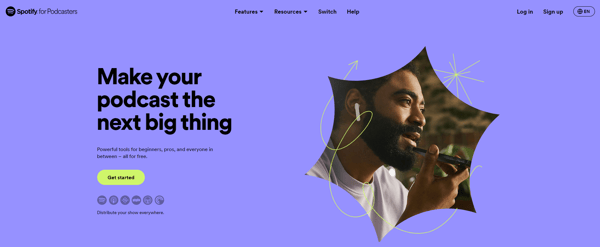
Video podcast: Is it worth it?
Even though a podcast is primarily made up of audio content, the past couple of years have seen a surge in video podcasts, too.
This is exactly what it sounds like. It’s a video recording of the podcast recording. Inception much?
Video podcasts are big among celebrity podcast hosts and other high-profile shows, and they can be an interesting model to pursue if you’re planning on receiving guests in your own studio.
The outcome will obviously be great: You’ll have beautiful video content that is also a podcast episode in and out of itself… But you’ll also need to invest a whole lot more to make this happen.
🎧 If you just want to learn how to start a podcast as a way to expand your business, then it might be worth sticking to the audio interface alone. Your business is (and should remain) your main focus, and you’re already investing a lot of money into it. There’s no need to spend more money on putting together a bonafide video studio, too.
How to make a podcast in 5 easy steps
We’ve covered the basics, but now it’s time to really dig our hands into the more practical side of how to start a podcast. Let’s check out the five main steps to make that podcast of yours really happen!
1. Pick out a podcast title
The first thing you’ll need to decide on is probably one of the hardest aspects of the whole endeavor: the name of your podcast.
Ideally, even though you’ll be recording a podcast that’s centered around your business, you might want to resist the urge to name it after your own online store. By opting for a new name altogether, you can reinforce the idea that the podcast is more of an independent project than an “advertising channel” for the brand.
Much like crafting a logo, picking out the podcast name is mainly about figuring out a title that’s entertaining, funny, and that sparks your potential listener’s interests. You don’t wanna risk going too overboard with a meme-worthy name, because that’ll make your podcast get really old really quickly, but you also don’t wanna get too stuffy or too formal, either.
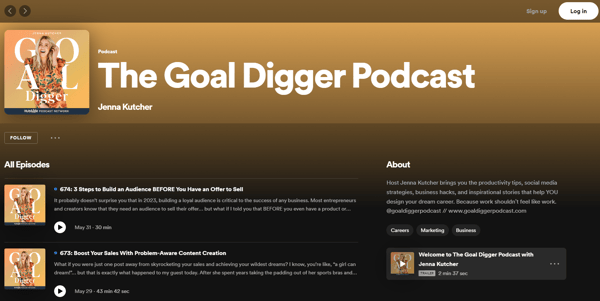
Jenna Kutcher’s podcast has one of the best names around, and it immediately gets listeners interested in what she has to say. It’s also a great reminder that you can brainstorm bigger names, and that you don't need to create a name that’s only one word long: Sometimes a phrase can work just as nicely.
Pro tip on how to start a podcast
Once you’ve settled on the podcast name, the next two things you should worry about are the podcast artwork and podcast description.
The podcast artwork (or podcast cover art) refers to the thumbnail that accompanies all episodes on a podcast app, like Apple Podcasts or Spotify. For Jenna Kutcher, it’s that wonderful picture of her and the “Goal Digger” lettering surrounding her―but you can also go for something a bit more eclectic.
“Gayest Episode Ever”, for instance, is a pop culture podcast that puts out a different podcast artwork for every new episode. Because the show is mainly focused on TV series, each artwork illustrates a character from the TV show they’ll be talking about.
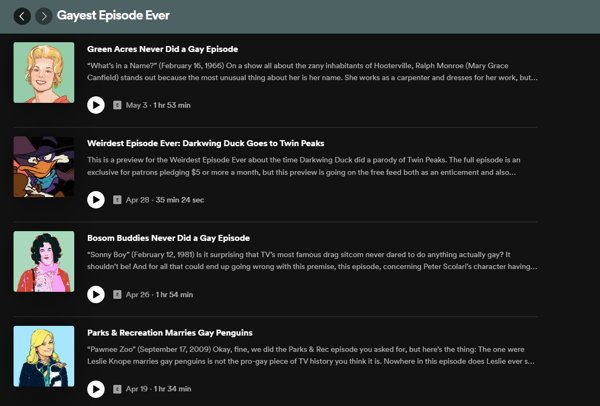
The podcast description, for its part, is kinda like an Instagram bio: it’s supposed to be short, sweet, and informative.
If we go back to Jenna Kutcher’s podcast, you can see that her show’s description is all about being concise: It lists the main topics she tackles on her episodes and it also lists the podcast website.
To top it all off, there’s also a two-minute trailer that presents the podcast and invites listeners to check out the episodes.
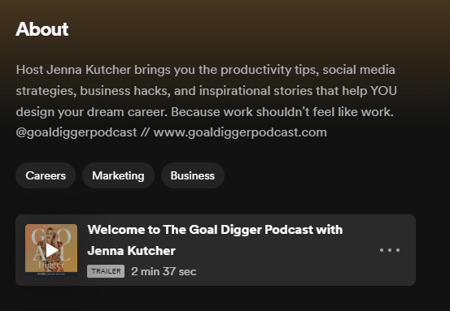
2. Choose your format
Next up on how to start a podcast is deciding on some specifics in terms of format. Here are the more pressing elements that should be aligned before you record your first episode:
- Format: Is your podcast focused on interviewing guests? Or do you want to follow the storytelling format, where you present a story or a topic to your podcast listeners?
- Podcast host: You can work alone or bring in another person to be your co-podcast host, but that’s it. Having too many different hosts can confuse listeners and make it harder for them to form a meaningful bond with your content.
- Episode length: Decide your ideal length and stick to it. You can do fifteen-minute episodes, thirty-minute ones or even longer.
- Topic or angle: You also need to decide what you’ll be talking about. The key is to work with a niche that’s related to your brand and that you master really well, so you can position your business as an authority.
- Intro music: A nice little opening is a great way to add consistency to a podcast, and you should definitely pick one that suits the theme and the overall identity you’re building inside a podcast app.
- Podcast script: Having a script for your podcast episodes is a must, whether you’re interviewing people or presenting a topic on your own. It’ll help you have more control over the content and make sure you aren’t skipping anything relevant.
3. Create a nice pace
Starting a podcast is also about figuring out the pace of your show. And this means settling on your speaking speed and the way you speak.
Here’s the thing: If you speak too fast, you might end up stressing your listener. But if you speak way too slowly, they’ll get bored and listen to something else.
As for the way you speak, try to talk like you were talking to a friend. Throw the big words and the jargon out the window and stick to a conversational tone, because the idea is to build a sense of proximity with your listeners. After all, you’re not giving them a lecture but rather presenting useful and valuable information.
4. Decide on a publishing cadence
One of the keys to creating a successful podcast is having a well-defined publishing cadence. You can put out new episodes weekly if you’re working with fifteen-minute episodes, or in a bi-weekly manner if you’re planning on making longer episodes.
Having a regular schedule is great to keep listeners coming back to your podcast because then they won’t forget about the show and will continually engage with the podcast website—and other related social media you might want to create.
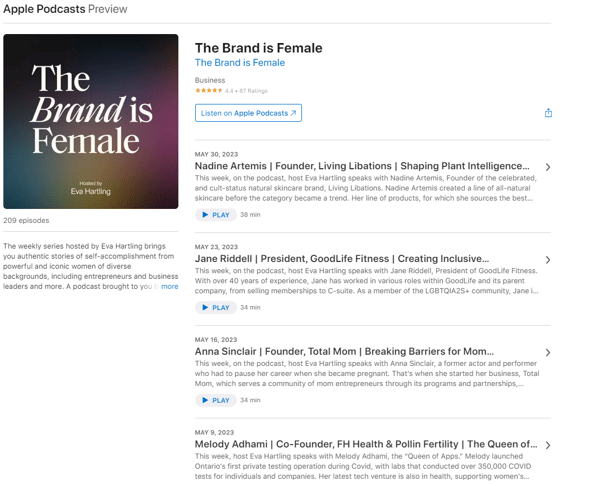
Here’s an example of publishing cadence: Because The Brand is Female publishes episodes of about thirty minutes, their team is able to publish one new episode per week.
5. Don’t forget the RSS feed
This last step on how to start a podcast involves a small but important action you’ll need to take together with your podcast hosting provider: creating and publishing the RSS feed.
The RSS feed is basically a small file that contains all of the relevant info about your podcast, like:
- Podcast name
- Podcast host
- Category or topic
- The idiom in which it was recorded
- Episode name and description
- Email address
This file needs to be submitted so that your podcast can be listed on streaming platforms like Apple Podcasts, Google Podcasts or Spotify―so make sure you get it right!
How to advertise a podcast?
Advertising and promoting a podcast isn’t really any different than advertising a business. You can always spend some money on paid traffic sources to bring in some new listeners, but the main angle you should take here is to invest in both SEO and organic content on other platforms.
Here’s what we mean by this:
SEO your content (and your website)
Yes, SEO is everywhere ― even on podcasts.
The truth is that a strong SEO strategy can help your podcast rank well inside platforms like Apple Podcasts, which in turn makes it easier for people to actually find your content. And here’s what you need to do to make sure you’re reaping good results:
- Create SEO-optimized episode descriptions, like you would when writing product descriptions or your store’s metadata. Try to position those juicy keywords right at the start, so that the algorithms can catch you right away.
- Implement your SEO during the podcast intro, thanking your listeners and encouraging them to subscribe and rate the episodes on the platform they’re on.
🎧 Here are some recommended reads to polish up your knowledge on SEO:
Post about your podcast on other platforms
To build a strong following on the internet, your podcast also needs to exist outside Apple Podcasts and other audio platforms―and that’s where social media kicks in.
You don’t need to go all in and create profiles on Instagram, TikTok, Twitter and YouTube; just pick the one that is more popular within your target audience and start posting to announce new episodes.
Twitter, for instance, is a great place for podcast accounts, not least because it’s a platform focused on sharing news and news-worthy content. Depending on your niche, you can take advantage of this and make sure you get your two cents in the conversation.
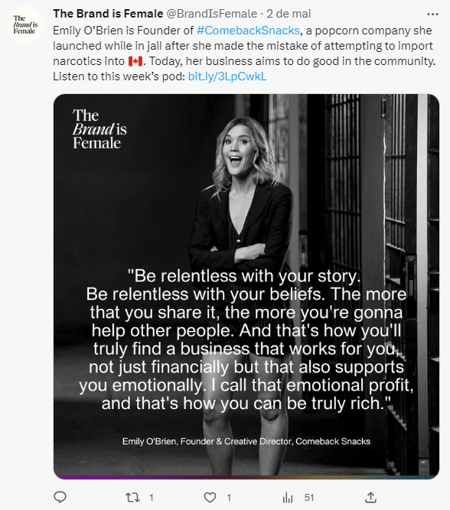
The Brand is Female, the podcast that we mentioned above, uses Twitter to announce new episodes and to share news about their sister podcasts as well.
Pro tip on how to start a podcast
There’s one last tip that we’d like to share with you on the topic of starting a podcast, and it has to do with turning your podcast listeners into actual customers.
To make this happen, you don’t need to sell them the items that you’re already selling online; you can make and sell merch for your podcast. This will help differentiate your podcast from the online store, while guaranteeing that you’re still able to monetize this new endeavor.
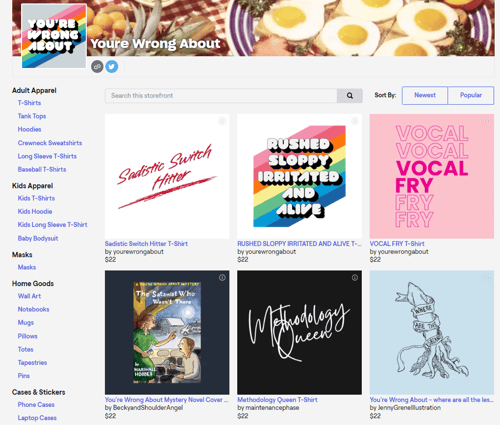
You’re Wrong About offers a wide array of merchandise, from tote bags to t-shirts and phone cases.
Talk their ears off!
And there you have it: everything you need to know about starting a podcast. We know it’s a lot of info to digest, so take all the time you need to craft your own podcasting strategy.
Remember: As a business, your main goal is not to create a podcast to advertise your products, but rather to establish yourself as an authority within a specific field. You want to think long-term and build a tight-knitted community of listeners right from the first episode.





